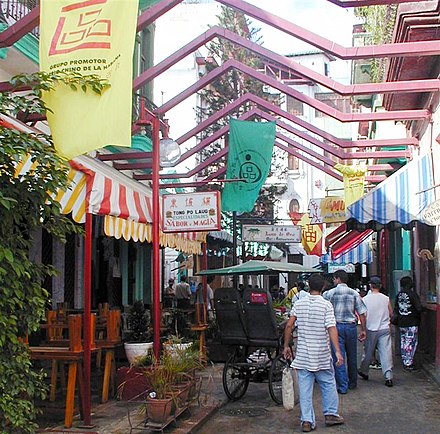Chinese Cubans (Spanish: chino-cubano) are Cubans of full or mixed Chinese ancestry who were born in or have immigrated to Cuba. They are part of the ethnic Chinese diaspora (or Overseas Chinese).

Chinese immigration to Cuba started in 1837 when Chinese (mainly Cantonese and Hakka) contract workers were forcibly brought to work in the sugar fields via the indentured labor system. Hundreds of thousands of Chinese workers were brought in from Qing China, British Hong Kong, Portuguese Macau, and Taiwan during the following decades to replace and/or work alongside African and mixed-ancestry slaves. After completing eight-year contracts or otherwise obtaining their freedom, some Chinese immigrants settled permanently in Cuba, although most longed for repatriation to their homeland. Havana's Chinatown (known as Barrio Chino de La Habana) is one of the oldest and largest Chinatowns in Latin America. Some 105,000 immigrants from the U.S. came to Cuba during the late 19th century to escape the discrimination present at the time. Another, albeit smaller wave of Chinese immigrants, also arrived during the 20th century, some as supporters of the communist cause during the Cuban revolution and others as dissidents escaping the authorities in China.
There were almost no women among the nearly entirely male Chinese "coolie" population that migrated to Cuba (1%).[2][3] Marriages of Chinese immigrants with Cuban mulatto, black and white women were reported by the Cuba Commission Report.[4]
In the 1920s, an additional 30,000 Cantonese and small groups of Japanese also arrived; both immigrations were exclusively male and there was rapid intermarriage with white, black and mulatto populations.[5]
In a study of genetic origins, admixture, and asymmetry in maternal and paternal human lineages in Cuba, thirty-five Y-chromosome SNPs were typed in the 132 male individuals of the Cuban sample. The study does not include any people with known Chinese ancestry. All the samples were white Cubans and black Cubans. Two out of 132 male samples belonged to East Asian haplogroup O2, which is found in significant frequencies among Cantonese people and is found in 1.5% of the Cuban population.[6] In the 1920s, an additional 30,000 Chinese arrived; the immigrants were exclusively male. In 1980, 4000 Chinese lived there, but by 2002, only 300 pure Chinese were left.[7]
Two thousand Chinese, consisting of Cantonese and Hakkas, fought with the rebels in Cuba's Ten Years' War. A monument in Havana honours the Cuban Chinese who fell in the war, on which is inscribed: "There was not one Cuban Chinese deserter, not one Cuban Chinese traitor."[8]
Chinese Cubans, including some Chinese Americans from California, joined the Spanish–American War in 1898 to achieve independence from Spain, but a few Chinese, who were loyal to Spain, left Cuba and went to Spain. Racial acceptance and assimilation would come much later.
When the new revolutionary government led by Fidel Castro came to power in 1959, the economic and political situation changed. Many Chinese business owners, having had their properties expropriated by the new government, left Cuba. Most of these settled in the United States, particularly nearby Florida, where they and their U.S.-born children are called Chinese Americans or Cuban Americans of Chinese descent, while a relatively few fled to the nearby Dominican Republic and other Latin American countries and also to the U.S. territory of Puerto Rico. As a result of this exodus, the number of pure Chinese dropped sharply in Havana's Barrio Chino. The places to which they migrated had a unique Chinese culture and a popularity of Chinese Cuban restaurants.

From a peak population of 60,000 in the 1950s, the Chinese Cuban population has virtually disappeared following the Cuban Revolution in 1959. The majority of Chinese Cubans fled to the United States, in particular to Miami, Florida but some also settled in California or elsewhere in Latin America.[9]
Of the Chinese who stayed after the start of Fidel Castro's rule in 1961, the vast majority were of mixed descent with the local population. Today, younger generations are working in a wider variety of jobs than the previous generation including medicine, engineering, and law. A 2011 figure estimates that about 20,000 Cubans are of Chinese descent.[1]
Once among the largest Chinatowns in Latin America, the Barrio Chino de La Habana is now the world's smallest and is primarily concentrated in a small alleyway dominated by Chinese restaurants. Most Chinese Cubans live outside Barrio Chino.[10]
Several community groups, especially Chinatown Promotional Group (Spanish: Grupo Promotor del Barrio Chino), worked to revive Barrio Chino and the faded Chinese culture. Chinese Language and Arts School (Escuela de la Lengua y Artes China) opened in 1993 and has grown since then, helping Chinese Cubans to strengthen their knowledge of the Chinese language. Today, Chinese Cubans tend to speak Mandarin, Cantonese, and Hakka in addition to Spanish and English and may speak in a mixture of Chinese and Spanish. They also promoted small businesses, like beauty parlors, mechanical shops, restaurants and small groceries, provided to them to create a view of Barrio Chino. Havana's Barrio Chino also experienced buildings of Chinese architecture and museum with backgrounds about China. As a result, the Chinese Cuban community has gained visibility.